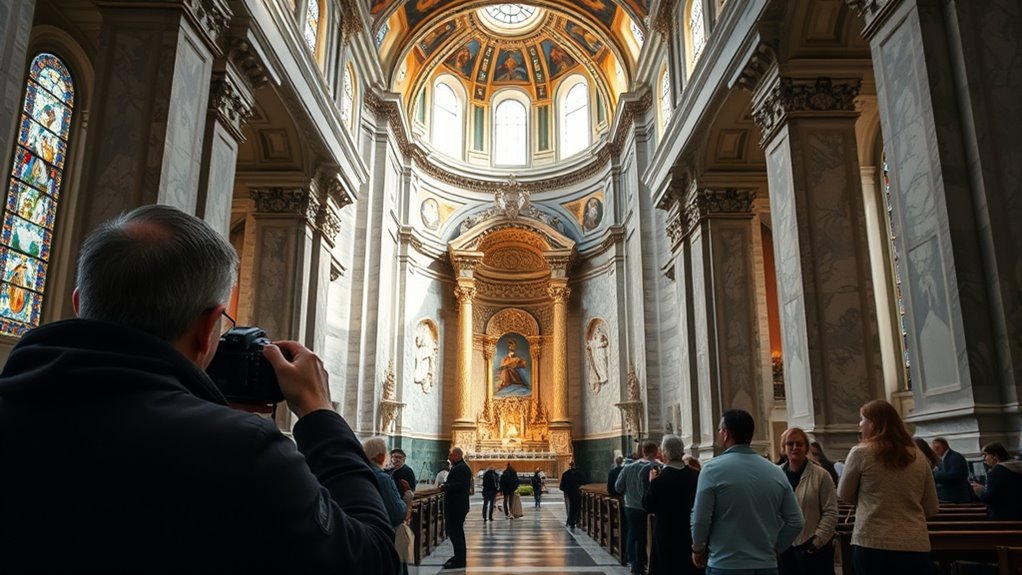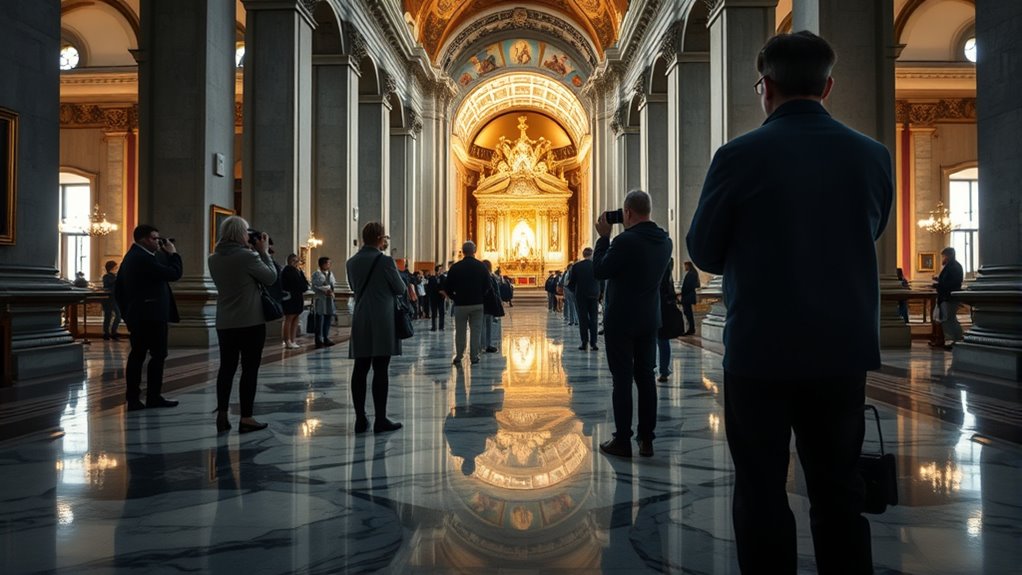When visiting Italian churches and museums, you should follow photography etiquette to show respect and protect the artwork. Turn off flash if photography is permitted, and keep noise and movements minimal. Avoid blocking aisles or taking disruptive selfies. Pay attention to signs or staff instructions, especially in sensitive areas. Remember, preserving the atmosphere benefits everyone. Sticking to these guidelines ensures you capture beautiful memories thoughtfully—more useful tips await your next steps.
Key Takeaways
- Always check and follow posted signs or staff instructions regarding photography restrictions and flash usage.
- Disable flash on your camera or smartphone unless explicitly permitted to prevent damage and disturbance.
- Maintain a quiet and discreet presence, avoiding loud noises, excessive movement, or blocking pathways.
- Respect designated no-photo zones and avoid taking photos during services or special ceremonies.
- Be considerate of other visitors by not lingering excessively and keeping your photography unobtrusive.

When visiting Italian churches and museums, understanding photography etiquette is essential to respecting the sacred and historic spaces. These sites often have specific rules designed to preserve their integrity and ensure everyone can enjoy their beauty. One of the most common guidelines involves lighting restrictions. Many locations restrict the use of flash photography because the intense light can damage delicate artworks, frescoes, and textiles over time. Recognizing these restrictions helps you avoid accidental harm to priceless artifacts. Instead, look for signs indicating whether photography is permitted without flash, and adjust your camera settings accordingly. Most modern cameras and smartphones allow you to turn off the flash easily, so take advantage of this to comply with the rules.
Flash photography is generally discouraged or outright prohibited in many Italian churches and museums. The reason is twofold: first, the bright flashes can cause physical damage to fragile surfaces, and second, they can disturb other visitors seeking a contemplative experience. When you’re allowed to take photos without flash, do so quietly and discreetly. Avoid using the flash even if it’s technically permitted, as it can be distracting and disruptive to others. Respect the environment by keeping your movements minimal and your noise levels low, especially during services or guided tours. If you’re unsure whether flash photography is allowed, look for posted signs or ask a staff member. Many sites have designated areas or specific times when photography is permitted more freely, so plan accordingly. Additionally, understanding the importance of color accuracy and how it influences the quality of your images can help you capture the beauty of these spaces more authentically.
Besides flash restrictions, be aware of other photography etiquette, such as not blocking aisles or doorways to take pictures. Respect the privacy and spiritual atmosphere of the space by avoiding intrusive behaviors like taking selfies or overly long shots that may detract from the experience of other visitors. When photographing artworks or architecture, try to do so efficiently, without lingering excessively on any single piece. Remember that some areas may be off-limits for photography altogether, often to protect sensitive artifacts or for security reasons. Always follow the guidelines provided by staff and posted notices.
Frequently Asked Questions
Are There Specific Times When Photography Is Allowed or Restricted?
You might wonder if there are specific times when photography is permitted or restricted. Generally, places have time restrictions or special photography hours, especially during busy periods or religious services. To avoid issues, check for signs or ask staff about any restrictions. Many sites set aside special photography hours to ensure visitors can take pictures without disturbing others. Always respect these rules to enjoy your visit and preserve the site’s integrity.
Can I Use Professional Camera Equipment Inside Churches and Museums?
Think of your camera gear as a key to hidden worlds, but in churches and museums, you must respect the rules. Usually, professional gear like tripods or large equipment isn’t permitted unless you have permission. Many sites restrict camera equipment to protect art and ensure visitors’ experience. So, check the rules beforehand, and if unsure, ask staff—your professional gear might need to stay outside or be used discreetly.
Are Flash Photography and Tripod Use Permitted During Visits?
You might wonder if flash photography and tripod use are permitted during your visit. Typically, flash restrictions are in place to protect artwork, so you should avoid using flash. Tripod rules often restrict their use to prevent damage and crowd disruption. Always check posted signs or ask staff for specific rules, as policies vary by location. Respecting these guidelines ensures you preserve the integrity of the exhibits and enjoy your visit responsibly.
How Should I Behave When Photographing Religious Artifacts or Artworks?
When photographing religious artifacts or artworks, you should always practice respectful behavior and respect traditions. Avoid using flash or taking photos in restricted areas, and be mindful of others praying or observing. Keep noise to a minimum and refrain from touching or leaning on artifacts. Your goal is to capture the beauty while honoring the sacred space, showing reverence and understanding for the significance these items hold.
Are There Any Penalties for Violating Photography Rules in These Sites?
Think of penalties enforcement as the gatekeeper of respect in sacred and cultural spaces. If you violate photography rules, the consequences can be serious, ranging from warnings to being asked to leave. Some sites may impose fines or restrict future visits, acting as a stern reminder to honor the rules. Ignoring them can tarnish your experience and lead to unavoidable violation consequences, so always follow the guidelines to keep the peace.
Conclusion
By respecting photography etiquette in Italian churches and museums, you help preserve these priceless treasures for generations. Your mindful actions keep the beauty and reverence alive, preventing memories from fading like shadows at sunset. Remember, a single photo taken without care can echo through history, tarnishing the sacred atmosphere. So, be considerate, follow the rules, and let your respect shine just as brightly as the masterpieces around you. Your mindfulness guarantees these wonders remain awe-inspiring forever.









